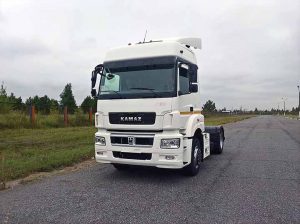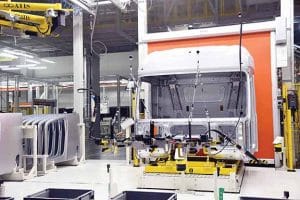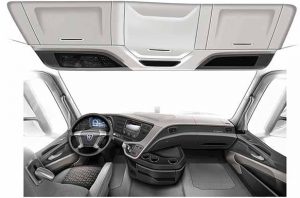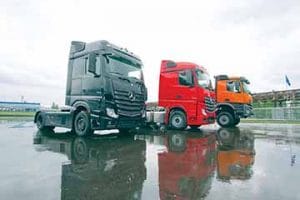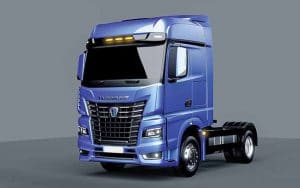A new cab factory commissioned by the joint venture between Daimler Group and Kamaz points at an interesting arrangement.
Story by Gianenrico Griffini
At first, it feels nondescript and even a little lonely for a manufacturing complex. A typical Soviet era structure that resembles a fort almost, it speaks about the country’s industrial prowess and more. It looks indestructible most of all, and is home to Kamaz. In what could be termed as an interesting development Russia’s CV industry, the joint venture between Daimler Group and Kamaz Rus has commissioned a new factory adjoining this fort-like structure at Chelny, Tatarstan, Russia. Turning out non-identical twins, the new factory is actually a cab manufacturing setup. With a production capacity of 55,000 units a year when fully functional, the facility has begun manufacturing Mercedes-Benz Actros and Arocs cabs, and cabs for the Russian manufacturer’s new truck ranges.
In fact, German technology has joined forces with Italian design at Naberezhnye Chelny in Tatarstan (Russian Federation). Built with an investment of Euro 200 million, the new cab factory has 700 employees. The Mercedes-Benz Actros and Arocs cabs it has begun turning out would be sold in the Russian Federation as Kamaz manufactures Mercedes-Benz Actros and Arocs as part of the joint venture in that fort-like seemingly indestructible manufacturing complex. The new-generation lorry cabs the factory has begun to turn out along-side shares the basic structure with that of the Actros and Arocs cab. These (Kamaz) cabs have been designed by Turin-based Torino Design. Flaunting smart looks outside and inside by Torino, the Kamaz new-generation cabs would be fitted to lorries used for distribution, long-haul operations and quarry as well as construction site activities.
Over the earlier generation Kamaz cabs that were said to have been based on the Mercedes-Benz axor cabs, the new-generation Kamaz cabs, sharing their architecture with the current generation Actros and Acros, mark a significant leap ahead in design, technology, ergonomics and application-ability. Made to tighter tolerances, the new cabs for Kamaz premium line of lorries speak about a certain engineering progress. They also speak about a leap in assembly sequences for all components. Spanning 59,600 square metres on the historic Kamaz production premises, the new cab factory has 120 robotic workstations designed for sheet welding and assembly operations and a high-tech painting department, created by the specialist German company Dürr. 3D printers have also been installed for the production of plastic spare parts. Operating under the Daimler Kamaz Rus JV, the new cab factory, according to Stefan Buchner, Head of Mercedes-Benz Trucks worldwide marks another key element in Daimler’s strategy to be close to its customers and to continuously strengthen its market presence around the globe. “With the new cab factory we have set a benchmark in the Russian market – to the benefit of both our customers and our Joint Venture partner Kamaz,” mentioned Buchner. “This plant,” he added, “is one of the most innovative facilities in the Russian automotive sector.”
Outlook for growth
With over 500 articulated lorries used to transport the equipment for the new facility from Europe to Chelny, the production site works closely with the Mercedes-Benz facility in Wörth (Germany). Representing another step in the global expansion of the Daimler Group, the new cab factory of Daimler Kamaz Rus is said to reflect Daimler Group’s long-standing association with Kamaz and the commitment to the Russian market. Kamaz, as an undisputed leader in heavy goods vehicles in the Russian Federation, is certain to profit from the ability of the new-edge and attractive looking cabs to draw its customers amid a shift in market requirements and expectations.
With Kamaz confident of the positive developments in terms of sales volumes growth in the Russian market over the mid- and long-term, the new cab factory accounts for an ambitious plan to carve out a niche in the receptive yet demanding mid- and the heavy-duty truck market in the Russian Federation. This, despite the uncertainties relating to the economy (the growth of GDP for this year was revised downwards against the global slowdown due to the Covid-19 pandemic), the fluctuations in the Euro-Ruble exchange rate (One-Euro is roughly equal to 72 Rubles), and the high bank interest rates on loans for purchasing capital goods, which is roughly around 10 per cent a year for customers with good credit ratings.
By opening the cab factory, the Daimler Group has also increased the localised production of components for the latest-generation Actros and Arocs vehicles, introduced in Russia in October of last year. At the moment, more than 150 vehicle components come from suppliers based in the Russian Federation, who are required to guarantee the same quality standards as their German and Western European counterparts. The decision to localise production was linked to the need to avoid import duties, which would make the vehicles less financially appealing to Russian hauliers.
Substantial differences
While the cab structure is the same for the Actros and new Kamaz 54901 vehicles (also known as K5), there are substantial differences to the external line, interior, and elements of the driveline. In the case of the Kamaz 54901, the engine is a six-cylinder in-line Liebherr model with a capacity of 12-litres. The strategic deal between the Russian manufacturer and the German company to develop a new family of 400-700 hp engines was signed in 2014, and production commenced with the first units in Chelny in March 2016. The gearbox is an automatic ZF TraXon 12-speed model.
The decision to have different drivelines differentiates the two different truck ranges in the domestic Russian market, avoiding range overlaps or situations of direct competition. Since the joint venture was established in 2009, Daimler Kamaz Rus has assembled over 30,000 Mercedes-Benz and Mitsubishi Fuso lorries in Chelny, and has sold them in the Russian Federation through a network of approximately 50 dealers located throughout this vast geographical region.
The cab design in the new Kamaz lorries – for a range of cabs that includes approximately 40 models, variants and versions – has the Italian touch provided by the company Torino Design, which has been in partnership with the Russian manufacturer since 2013. “At the beginning of the partnership Kamaz basically wanted to restyle the models already being produced,” explained Roberto Piatti, CEO and Managing Director of the Italian design company.
However, in 2014, the Russian manufacturer reached an agreement with Mercedes-Benz per to use the Actros cab structure in their vehicles, radically changing the design focus. The Russian management team decided to stop the restyling process and concentrate instead on developing a new modular range of cabs. The characteristic of modularity – in relation to savings on investments for construction components – was one of the key concepts underlying the new cabs. The project commenced between the summer and autumn of 2014, whereas the design of the templates was ‘frozen’ at the end of the year. Subsequently the 3D models were developed, and the vehicle samples cut to a scale of 1:1.
The initial presentations were delivered to the senior Russian managers in February 2015. At the same time a demonstration lorry was created for the industrial vehicle trade fair in Moscow in 2015, offering a wide range of innovative solutions. After several months of optimisation, the designs were set in May 2015.
Has the partnership with Kamaz been different to relationships with lorry manufacturers in other countries? “Of course. We usually deal with styling, 3D modelling and design templates through to the finalisation of the feasibility and design phase. However, in the case of Kamaz, we also dealt with all development and engineering. This complex task involved a team of 100 to 120 specialists. It wasn’t an easy task, as the Actros structure had to be combined with the original components of the Kamaz vehicles, while maintaining the Kamaz brand identity,” says Piatti.
……………………………………………………..
CV is an associate member of the International Truck of the Year (IToY). As part of this association, the magazine provides exclusive articles, written especially by IToY jury members.
Lorries in the Russian Federation
The Russian market for CVs over 3.5-tonnes grew by three per cent in 2018 on a year-on-year basis. Overall, some 81 000 lorries were put on the roads. Some 38,000 of these were produced by national manufacturers. Approximately 42,500 of these were by Western European makes. Kamaz had the largest market share in 2018, a situation which continues till date. In the second place was Gaz, followed by Scania, Volvo Trucks, Man and Mercedes-Benz. The top-selling model in 2018 was the Kamaz 43118 6×6 (more than 6,500 put on the roads), testifying to the difficult operating conditions for vehicles operating in the Russian Federation.
Another Kamaz vehicle, the 6×4 65115, took third place (5,545 units), behind the mid-range Gazon Next 4×2 (6,168 vehicles registered). The lion’s share of the heavy goods department, in terms of sales volumes, went to tractors (30,647 units), followed by tipper trucks (12,700 vehicles), special vehicles (8,700 units) and box lorries (6,600 vehicles). Figures for the first five months of 2019 showed an overall fall of more than five-per cent in the market with respect to 2018. Sales of Western vehicle makers have also decreased (-14 per cent).





